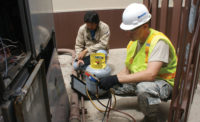
The testing of LEED for Homes is scheduled to run through the end of 2006. Once it is completed, the system will be revised and voted on. LEED is planning for the completed program to be fully chartered by early 2007.
According to LEED, a "green" home is a high-performance home that is built to exceed the minimum requirements of the building, especially in the areas of indoor environmental quality and resource efficiency. "Green buildings are designed to enhance operational performance, improve occupant health, save energy, and contribute to a cleaner and safer environment," said Thomas Jackson, CEO of Jackson Systems LLC.
LEED calls this new project a voluntary initiative to actively direct the home industry towards sustainable practices. LEED for Homes is designed to work towards a national consistency in the residential green building sector.
A home qualifying for LEED certification must meet Energy Star® for homes requirements as stated on the LEED for Homes checklist. According to Energy Star, HVAC equipment makes a large difference in home efficiency. Furnaces must be rated to at least 90 AFUE. Central air conditioners must be at least 14 SEER in order to qualify for an Energy Star label.
"In addition to increasing system efficiency, homeowner comfort levels are significantly increased, which is a major factor of a quality indoor environment," said Brad Paine, zoning product manager, Honeywell.
There are multiple shades of green in this new program. (The term "shades of green" is defined by LEED as the various levels of achievement in adopting resource efficiency in a home. It refers to homes with few green measures as light green, and homes with many green measures as dark green.)
"Zone control contributes to energy savings and system efficiency," said Jackson. "It is rapidly becoming a standard part of green building design."
GREEN SAVES
Energy Star is currently forecasting energy demand to grow 40 percent by the year 2025."It takes a lot of energy to heat or cool the entire home," said Dick Foster, president, Zone First. "It only takes a small amount of energy, however, to raise or lower the temperature a couple of degrees in a single room or zone. Think if every home had zoning; this demand could be almost offset."
"When air conditioning loads are not consistent throughout a building, it creates a condition known as diversity," said Timothy Thorson, product manager of residential controls, Lennox Industries. Zoning helps handle the diversity and can save homeowners money.
"Energy savings with zoning, while not well documented, are very typically 25 percent to 30 percent over single-zone systems," said Jackson.
There are other advantages to constructing a home that meets LEED certification standards. According to Energy Star, a qualified new home offers significant utility bill savings and can give the homeowner access to special financing options, such as energy-efficiency mortgages. There are also product rebates and, at times, reimbursements for the cost of the required third-party verification testing.

GREEN MARKETING
According to Dave Bohlmann, director of technical support, KMC Controls, "The call for individual comfort control once again pushes the frontier of HVAC zoning."LEED requirements are to provide individual comfort controls for 50 percent (minimum) of the building occupants, enabling adjustments for individual needs and preferences and providing comfort system controls for all shared, multioccupant spaces to enable adjustments to suit group needs and preferences," he continued.
"There are requirements to design HVAC systems to meet ASHRAE Standard 55-2004, to support occupant satisfaction with building performance," said Bohlmann. "Zoning itself helps monitor comfort ability and overall system performance - allowing fulfillment of LEED criteria."
Residential new construction is growing rapidly, and the No. 1 complaint in residential new construction is the HVAC system, creating more opportunities for selling value-added products to homeowners. Only about 10 to 25 percent of the HVAC market, however, currently use zoning, according to Paine and Dave Arneson, zoning product specialists, Honeywell. Paine and Arneson suggested that regulating zoning might give it the push it needs to become a common practice, just as the 13 SEER regulation increased the market approximately 30 percent when it went into effect.
Homeowners, contractors, and the environment are steadily finding new opportunities to profit from the LEED for Homes project. According to Paine and Arneson, "Everyone wins with zoning."
Publication date: 05/15/2006



